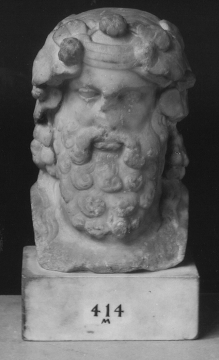Explore Collections


You are here:
CollectionsOnline
/
A terminal bust of the bearded Dionysos (or Dionysius)
Browse
A terminal bust of the bearded Dionysos (or Dionysius)
Early Imperial
Pentelic marble
Height (excluding modern base): 21cm
Museum number: M414
On display: Catacombs
All spaces are in No. 13 Lincoln's Inn Fields unless identified as in No. 12, Soane's first house.
For tours https://www.soane.org/your-visit
Curatorial note
The face of this bust, which is a pale Hellenistic reflection of a fifth century BC type, is framed on three sides by a heavy wreath of fillets across the forehead, vine and ivy leaves, and grapes; on the neck and shoulders either side of the beard appear long strands of hair summarily treated partially in relief, partially by incision. The heavy moustache and beard are composed of lumpy curls, the details of which are also finished by incision - in vague recollection of treatment in bronze in the latest Archaic and earlier High Classic periods.
Small busts such as these, of mixed antecedents and partially recalling the Hermes Propylaeus of Alcamenes (at Pergamon in Antiquity) or a similar type, were popular features of later Republican and early Roman Imperial household ornament. Professor Bernard Ashmole notes: 'Such terminal busts, which are very numerous, have been found in position in niches near doorways at Pompeii, and the flat back shows that this was made for a like purpose'2, or possibly attached to a column.
This small bust represents an aspect strikingly like its counterpart in the art of the gem engraver - a red jasper signed by Aspasios and in the British Museum.3
The subject of Roman copies of Herms or terminal busts in the style of Alcamenes or Phidias is discussed by James R. McCredie in 'Two Herms in the Fogg Museum', American Journal of Archaeology (AJA), 66, 1962, pp.187-189, pl.56; see also AJA, 68, 1964, p.324. Both articles give references for additional decorative examples and all the recent picture-books on Pompeii and Herculaneum include views of Herms like the Soane example installed in Roman houses and gardens. See, for example, J. Lukas and M. Wheeler, Pompeii and Herculaneum, London, 1966, p. 76: example in the peristyle of the House of the Golden Cupids at Pompeii (also pp. 90-91, in the peristyle of the House of the Vettii). A more recent study on sculptural decoration in Roman villas is: Richard Neudecker, Die Skulpturenausstattung römischer Villen in Italien, Mainz 1988.
1 Alcamenes of Athens was a sculptor and younger contemporary of Phidias (active c.465-425 BC).
2 B. Ashmole, A catalogue of the ancient marbles at Ince Blundell Hall, Oxford 1929 Ince, p. 66, nos. 165-166, pl. 2.
3 G.M.A. Richter in George E Mylonas and Doris Raymond (eds), Studies Presented to David Moore Robinson, I, 1951 p. 720, pl. 86, e). (ICS: 202 WI: KFI 150).
Small busts such as these, of mixed antecedents and partially recalling the Hermes Propylaeus of Alcamenes (at Pergamon in Antiquity) or a similar type, were popular features of later Republican and early Roman Imperial household ornament. Professor Bernard Ashmole notes: 'Such terminal busts, which are very numerous, have been found in position in niches near doorways at Pompeii, and the flat back shows that this was made for a like purpose'2, or possibly attached to a column.
This small bust represents an aspect strikingly like its counterpart in the art of the gem engraver - a red jasper signed by Aspasios and in the British Museum.3
The subject of Roman copies of Herms or terminal busts in the style of Alcamenes or Phidias is discussed by James R. McCredie in 'Two Herms in the Fogg Museum', American Journal of Archaeology (AJA), 66, 1962, pp.187-189, pl.56; see also AJA, 68, 1964, p.324. Both articles give references for additional decorative examples and all the recent picture-books on Pompeii and Herculaneum include views of Herms like the Soane example installed in Roman houses and gardens. See, for example, J. Lukas and M. Wheeler, Pompeii and Herculaneum, London, 1966, p. 76: example in the peristyle of the House of the Golden Cupids at Pompeii (also pp. 90-91, in the peristyle of the House of the Vettii). A more recent study on sculptural decoration in Roman villas is: Richard Neudecker, Die Skulpturenausstattung römischer Villen in Italien, Mainz 1988.
1 Alcamenes of Athens was a sculptor and younger contemporary of Phidias (active c.465-425 BC).
2 B. Ashmole, A catalogue of the ancient marbles at Ince Blundell Hall, Oxford 1929 Ince, p. 66, nos. 165-166, pl. 2.
3 G.M.A. Richter in George E Mylonas and Doris Raymond (eds), Studies Presented to David Moore Robinson, I, 1951 p. 720, pl. 86, e). (ICS: 202 WI: KFI 150).
Unrecorded.
Soane collections online is being continually updated. If you wish to find out more or if you have any further information about this object please contact us: worksofart@soane.org.uk


